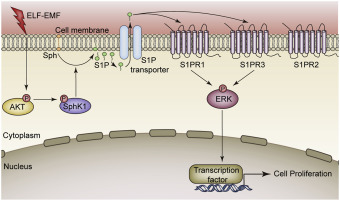Ecotoxicology and Environmental Safety ( IF 6.2 ) Pub Date : 2020-03-05 , DOI: 10.1016/j.ecoenv.2020.110407 Liangjing Chen 1 , Yongpeng Xia 1 , Jingchun Lu 1 , Qixin Xie 1 , Anfang Ye 2 , Wenjun Sun 3

|
Extremely low-frequency electromagnetic fields (ELF-EMFs) present a kind of common non-ionizing radiation in public and occupational environments. Previous studies have suggested that ELF-EMF exposure might have a potential impact on co-carcinogenesis and the progression of tumorigenesis by inducing cell proliferation. However, the underlying mechanisms remain largely unknown. In this study, we investigated the possible role of the sphingosine-1-phosphate (S1P)-related pathway in regulating cell proliferation induced by 50-Hz, 0.4-mT magnetic-field (MF) exposure. The results showed that MF exposure significantly promoted sphingosine kinase 1 (SphK1) activity, and that inhibition of the SphK1–S1P–S1P receptor (S1PR) pathway could remarkably reverse MF-induced cell proliferation. Additionally, we could infer indirectly from an exogenous-S1P experiment that MF-induced S1P might act on S1PR1/3 in a paracrine and/or autocrine manner to mediate the proliferation effect. Notably, although the MF activated the extracellular signal-regulated kinase (ERK) and protein kinase B (Akt) pathways, the SphK1–S1P–S1PR1/3 cascade regulated MF-induced proliferation by activating the ERK rather than the Akt pathway. Taken together, the findings of this study indicated that the SphK1–S1P–S1PR1/3 cascade played an important role in MF-induced proliferation by mediating the ERK signaling pathway, which could bring new insights into understanding and preventing the adverse effects of MFs.
中文翻译:

50 Hz磁场暴露通过SphK-S1P-S1PR级联介导的ERK信号通路促进人羊膜细胞增殖。
极低频电磁场(ELF-EMF)在公共和职业环境中呈现出一种常见的非电离辐射。先前的研究表明,暴露于ELF-EMF可能通过诱导细胞增殖而对共致癌作用和肿瘤发生进展产生潜在影响。但是,其基本机制仍然未知。在这项研究中,我们调查了鞘氨醇-1-磷酸(S1P)相关途径在调节50 Hz,0.4 mT磁场(MF)暴露诱导的细胞增殖中的可能作用。结果表明,MF暴露显着促进了鞘氨醇激酶1(SphK1)活性,并且抑制了SphK1 – S1P –S1P受体(S1PR)通路可以显着逆转MF诱导的细胞增殖。此外,我们可以从外源性S1P实验间接推断出MF诱导的S1P可能以旁分泌和/或自分泌的方式作用于S1PR1 / 3,以介导增殖作用。值得注意的是,尽管MF激活了细胞外信号调节激酶(ERK)和蛋白激酶B(Akt)途径,但SphK1 – S1P – S1PR1 / 3级联通过激活ERK而非Akt途径来调节MF诱导的增殖。两者合计,这项研究的结果表明SphK1 – S1P –S1PR1 / 3级联通过介导ERK信号通路在MF诱导的增殖中发挥重要作用,这可能为了解和预防MF的不良影响带来新的见解。











































 京公网安备 11010802027423号
京公网安备 11010802027423号